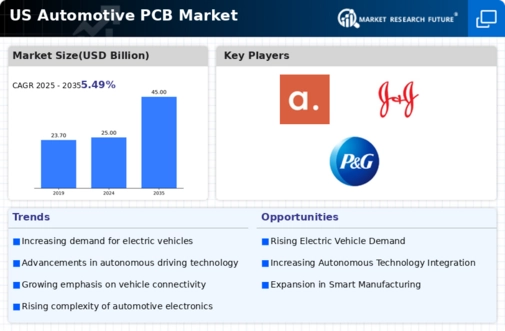Rise of Autonomous Driving Technologies
The automotive pcb market is poised for growth due to the rise of autonomous driving technologies. As vehicles become more automated, the demand for sophisticated electronic systems increases, necessitating advanced PCBs that can handle complex functionalities. This trend is likely to propel the market, with projections indicating that the segment related to autonomous systems could grow by over 25% by 2027. The integration of sensors, cameras, and other electronic components into vehicles requires high-performance PCBs, thereby driving innovation and investment in the automotive pcb market.
Growing Demand for Connectivity Solutions
The automotive pcb market is significantly influenced by the increasing demand for connectivity solutions in vehicles. As consumers expect seamless integration of their devices with automotive systems, manufacturers are compelled to incorporate advanced PCBs that support technologies like V2X (Vehicle-to-Everything) communication. This trend is expected to drive the market, with estimates suggesting that the connectivity segment could account for over 30% of the total automotive pcb market by 2026. The need for reliable and efficient communication systems is pushing manufacturers to innovate, thereby enhancing the overall growth of the automotive pcb market.
Increased Focus on Vehicle Electrification
The automotive pcb market is significantly impacted by the increased focus on vehicle electrification. As manufacturers shift towards electric and hybrid vehicles, the demand for specialized PCBs that can support high-voltage applications is rising. This shift is expected to contribute to a market growth rate of around 10% annually through 2030. The need for efficient power management systems and battery management solutions is driving the development of advanced PCBs tailored for electric vehicles. Consequently, this trend is likely to reshape the landscape of the automotive pcb market, fostering innovation and new product development.
Regulatory Compliance and Safety Standards
The automotive pcb market is also shaped by stringent regulatory compliance and safety standards imposed by government agencies. These regulations necessitate the use of high-quality materials and manufacturing processes to ensure the reliability and safety of automotive electronics. For example, the National Highway Traffic Safety Administration (NHTSA) has established guidelines that impact PCB design and manufacturing. Compliance with these standards not only enhances product safety but also boosts consumer confidence, which is vital for market growth. As a result, manufacturers are increasingly investing in quality assurance processes, thereby positively influencing the automotive pcb market.
Technological Advancements in PCB Manufacturing
The automotive pcb market is experiencing a surge due to rapid technological advancements in PCB manufacturing processes. Innovations such as automated assembly and advanced materials are enhancing production efficiency and reducing costs. For instance, the introduction of high-density interconnect (HDI) technology allows for more compact designs, which is crucial for modern vehicles that require more electronic components. The market is projected to grow at a CAGR of approximately 8% from 2025 to 2030, driven by these advancements. Furthermore, the integration of smart manufacturing techniques is likely to streamline operations, thereby increasing the competitiveness of manufacturers in the automotive pcb market.














Leave a Comment